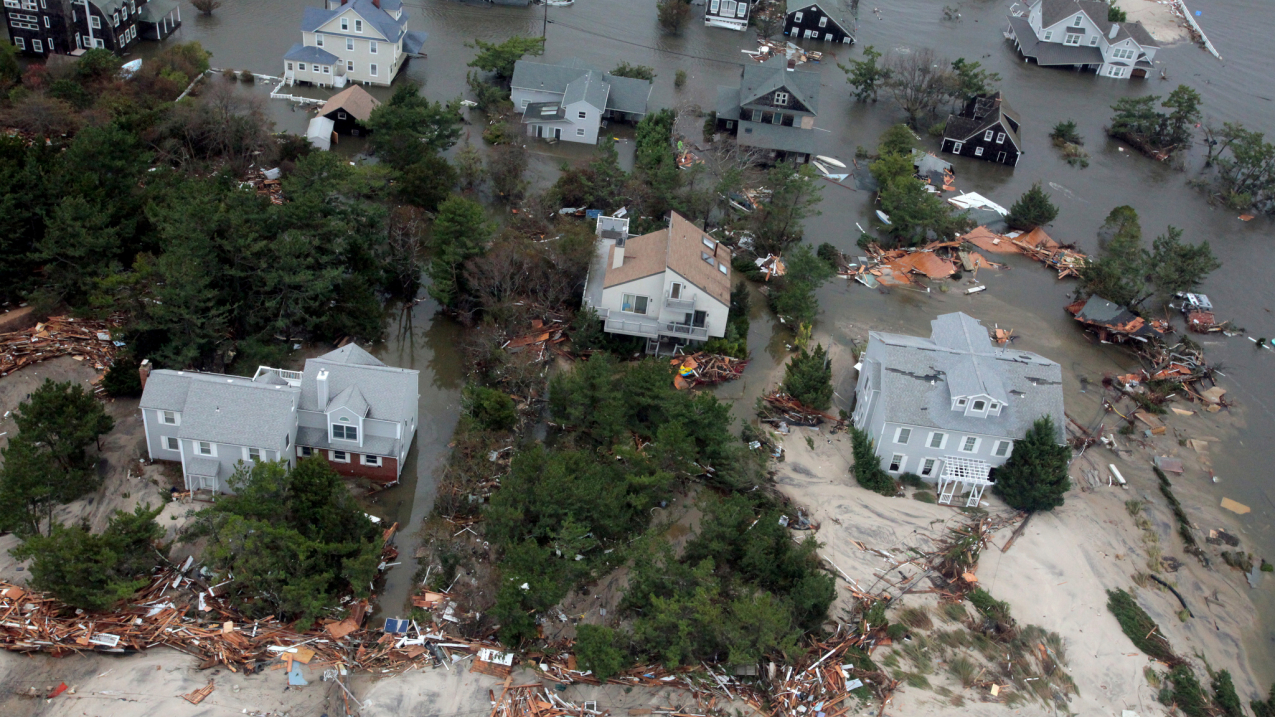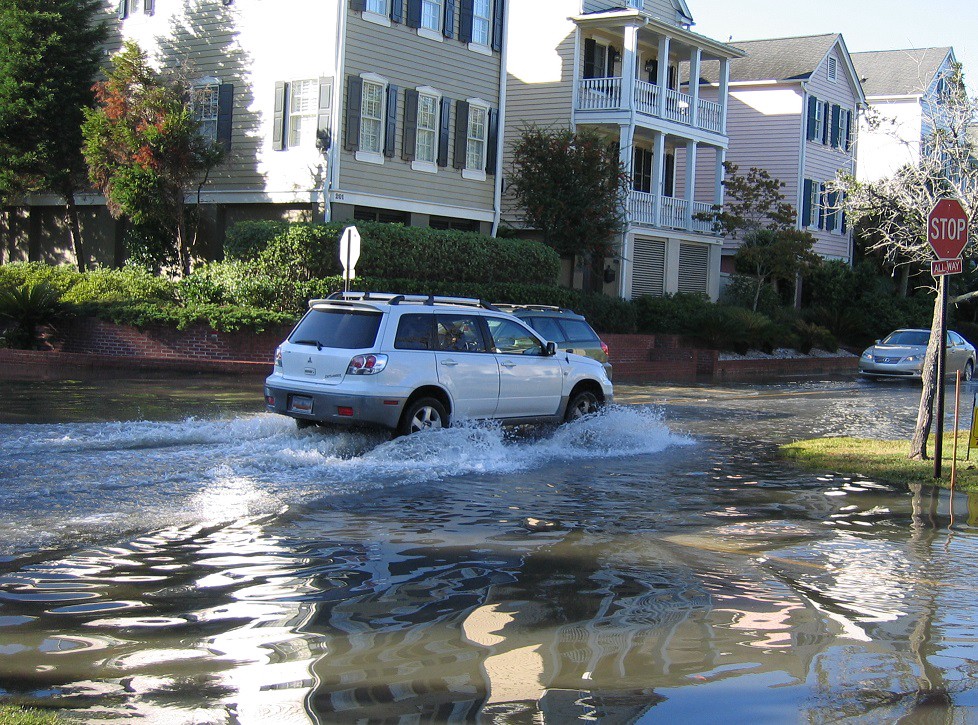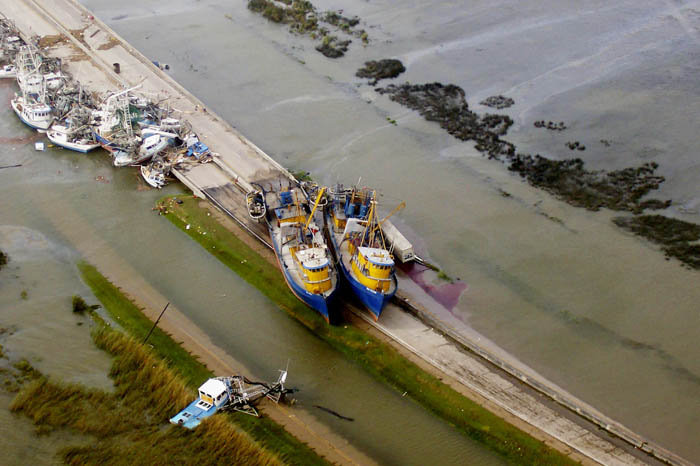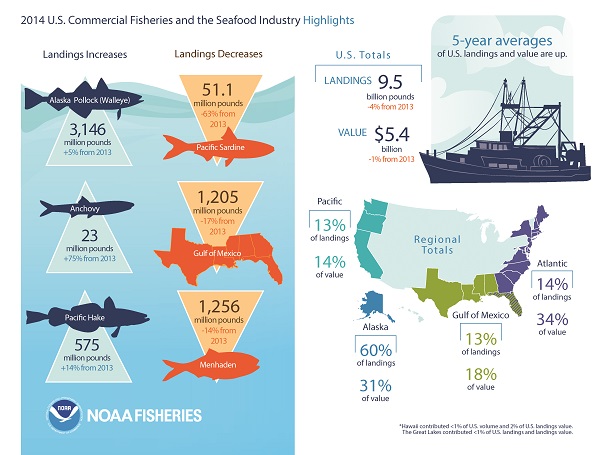
An overflight shows some of the damage that Hurricane Sandy caused when it hit the east coast at the end of October, 2012. (Image credit: US Air Force)
Resilience 101: How America can withstand wild weather
What is resilience?
Safeguarding coastal areas
Vulnerability across all regions
Business interests at risk
Building a ready and resilient nation
Communities across the country are increasingly vulnerable to natural disasters and long-term adverse environmental change. Coastal storms, water inundation, flooding, drought, wildfires, and tsunamis all pose a threat to lives, livelihoods, and the ecosystems on which we depend.
At the same time, population growth, expanding community development, and loss of natural resources, habitat, and species are happening in areas that are especially exposed to increasing threats related to climate and environmental change.
For these reasons, communities, businesses, and governments are turning to NOAA for the environmental information they need to make informed choices to assess risk, minimize losses, and protect the things they care about. They are developing plans and undertaking efforts to capitalize on opportunities, reduce vulnerabilities, adapt to change, and to ensure they are prepared for the future. In a word, they are becoming resilient.
Resilience is important everywhere because all communities face hazard threats such as droughts and flooding. Coastal areas have additional hazard risk from storms such as hurricanes and increased population pressures, making resilience particularly important in those locations. (NOAA)
Resilience is the ability to prepare and plan for, absorb, recover from, and more successfully adapt to adverse events, as defined by the National Academies of Science.
Supporting national resilience is at the heart of NOAA’s mission to protect lives and livelihoods and improve long-term sustainability. Through public investment in monitoring and observing systems, including ships, planes, satellites, buoys and tide gauges, NOAA provides the environmental information critical to living and working smarter. Our goal is to ensure that every American community is ready, responsive, and resilient to accelerating vulnerability to extreme weather, water, and climate events.
This primer provides an overview of what drives weather and climate extremes, how NOAA’s scientific data and observational investments support emergency managers and planners, and the steps we are taking to help people and business operators stay weather-ready and climate smart.
More than half of the U.S. population (52%) live on the coast. More than 123 million Americans, or 39% of the nation’s population, live in counties directly on the shoreline. Coastal areas are substantially more crowded than any other part of the country, and population density in these areas is expected to increase in the future.
Food. Transportation. Trade. Recreation. Jobs. Coastal communities in the United States provide vital economic, social and recreational opportunities for Americans everywhere. Strengthening resilience in coastal areas is particularly important as they face additional risk due to tropical storms and increased population pressures.
Sea level rise is the primary long-term threat to the coast--particularly in areas like the Gulf of Mexico where naturally sinking land exacerbates the problem. The two major causes of global sea-level rise are thermal expansion caused by the warming of the oceans (since water expands as it warms) and the loss of land-based ice (such as glaciers and polar ice caps) due to increased melting. Records show that sea level has been steadily rising at a rate of 0.04 to 0.1 inches per year since 1900, and researchers indicate the globally averaged sea level could rise 8 inches to 6.6 feet by the end of the century. See sea level trends in your area and view potential impacts.

But it no longer takes a storm or hurricane to cause the type of flooding that can close roads, overwhelm storm drains, damage buildings, or otherwise inconvenience daily life. This ‘nuisance flooding’ is a worsening symptom of sea level rise. In addition to monitoring water levels and issuing flood warnings, NOAA scientists are working closely with local planners and public safety managers to develop short and long term strategies to adapt and be resilient to this new normal.
NOAA also provides data, tools, and community consultation on other threats that challenge the resilience of coastal cities, that include watching for outbreaks of toxic algae that degrade water quality and halt water delivery, as well as mobilizing scientific support should a maritime accident occur with debris that endangers mariners or spilled oil that threatens the coastline.
Every region of the United States is expected to experience dramatic environmental changes as the climate continues to warm. The vulnerability of our communities to extreme weather and climate events makes resilience one of the most pressing challenges of our time.
According to NOAA and other federal scientists, in the Northeast, rising ocean temperatures could shift populations and abundance of the economically-valuable cod fishery. In the Southeast and Southern Plains, more days of extreme heat will affect health, energy, and agriculture. Midwestern states could see increased heavy downpours and floods, which will challenge forestry and farming. Out West, the Northwestern, Southwestern and Great Plains states can expect more droughts, and with that, more stress to water supplies as well as more potential for favorable wildfire and mudslide conditions.
Up north, Alaska is warming twice as fast as the rest of the nation, bringing both opportunities and challenges for citizens and natives; however, rising ocean acidity and melting ice also mean big trouble for existing wildlife and newly migrating animals. Hawaii and U.S. Pacific island territories also must cope with warming oceans, which spark coral bleaching events that alter the health and distribution of fish species--a major source of food for the nation.
A common issue that each region shares is the availability and quality of our water supply, which is in jeopardy given climate change, growing human populations, and increasing demands for the resource. Longer dry spells now and in the future are resulting in water scarcity, and the quality of water is diminishing in many areas due to increasing sediment and contaminant concentrations after heavy downpours.
NOAA Fisheries, the California Department of Fish & Wildlife, water control agencies and private landowners come together to find ways to ration water for endangered salmon survival during the California drought. (NOAA)
Innovative thinking is key for communities and businesses that must adapt to climate change, and NOAA is uniquely positioned to provide the data they need to strengthen their resilience. Our extensive and powerful networks of satellites, weather stations, river gauges, ocean buoys, and ships and planes are tracking the pulse of the planet every day.
Extreme weather threatens the supply chain. Climate extremes threaten farming and fishing. Weather forecasts and climate predictions not only help customers reduce costs and businesses protect profits--they also move markets. Resilience is smart for business and cannot be avoided.

Across the country, we see organizations making impressive uses of NOAA’s weather, water, and climate data. The Risky Business Project offsite link reports that major retailers are using hourly and weekly forecasts to keep cargo and transportation operations running smoothly and quickly. Air carriers are transmitting real-time wind and atmospheric data to pilots that help them avoid turbulence and keep passengers safe. And energy companies are using seasonal predictions to more precisely deliver electricity and gas and upgrade vulnerable infrastructure that could disrupt power.
Remarkable advances in Earth observing technology made these innovations possible. But it is these businesses’ vulnerability that makes innovation critical. And in the natural resources world, where farming and fishing are multi-billion dollar industries key to our nation’s food security, NOAA conducts important science that inform policies and ensures that these resources and their habitats are sustainable for generations to come.

Managing the nation’s offshore fisheries is one of NOAA’s core functions. Though a regional council process, we work with state governments, commercial and recreational industries, and environmental organizations on policies to sustain the seafood supply and combat costly illegal, unreported and unregulated fishing. Our teams of biologists conduct assessments on many fish species, including threatened and endangered stocks, and are studying how a climate change and ocean acidification are affecting the abundance and health of species over the long-term.
In an era where extreme weather and climate events are more commonplace, we see industries, insurers, communities, and governments treat Earth data as a global public good. And that's precisely what it is--a free and unbiased commodity for every major business investment and important decision, from erecting energy efficient buildings, to engineering landscapes that are less susceptible to floods, fires, and storms.
A resilient community is able to rebound quickly from dangerous and costly weather and climate extremes. But its ability to successfully recover is linked to the strengths and capacities of individuals, families, businesses, schools, hospitals, and other parts of the community.
Resilience has three dimensions: societal, economic, and ecological. NOAA incorporates all three into the data and services being delivered on the ground and in communities. We are not just doing the science; we are constructing the value chain that moves observation, data, and information into knowledge and action. With our partners, NOAA is working to build a Weather-Ready Nation and one that is climate smart.

Because all communities face multiple hazards, resilience is important. While most communities effectively prepare themselves to respond to emergency situations, many are not adequately prepared to recover in the aftermath and also plan for the future. We provide guidance to local facilities and even entire cities that need our help in taking steps to be ready for storms, tsunamis, and other types of dangerous weather.
A key tool communities can use to examine their vulnerability to sea-level rise and other climate impacts is the U.S. Climate Resilience Toolkit, developed by NOAA and our other federal agency partners. It offers information from across the federal government in one easy-to-use location so that Americans are better able to understand climate-related risks and take steps to improve their resilience.
For many Americans, adapting to new climate regimes means developing new expertise. Decision-makers across the nation are using data and tools to reduce their risks and protect their investments from climate. This video explains how you can use the Climate Resilience Toolkit web site to improve resilience. (NOAA)
No one can overrule Mother Nature, but there are actions we can take together to build resilient communities and to keep commerce moving. Across NOAA, we are improving the National Weather Service, and investing in the next generation of Earth observation platforms, that together will deliver the timely, actionable environmental data we all need to stay safe, healthy and productive.
Communities across the country are increasingly vulnerable to natural disasters and long-term adverse environmental change. Coastal storms, water inundation, flooding, drought, wildfires, and tsunamis all pose a threat to lives, livelihoods, and the ecosystems on which we depend.
At the same time, population growth, expanding community development, and loss of natural resources, habitat, and species are happening in areas that are especially exposed to increasing threats related to climate and environmental change.
For these reasons, communities, businesses, and governments are turning to NOAA for the environmental information they need to make informed choices to assess risk, minimize losses, and protect the things they care about. They are developing plans and undertaking efforts to capitalize on opportunities, reduce vulnerabilities, adapt to change, and to ensure they are prepared for the future. In a word, they are becoming resilient.
Resilience is important everywhere because all communities face hazard threats such as droughts and flooding. Coastal areas have additional hazard risk from storms such as hurricanes and increased population pressures, making resilience particularly important in those locations. (NOAA)
Resilience is the ability to prepare and plan for, absorb, recover from, and more successfully adapt to adverse events, as defined by the National Academies of Science.
Supporting national resilience is at the heart of NOAA’s mission to protect lives and livelihoods and improve long-term sustainability. Through public investment in monitoring and observing systems, including ships, planes, satellites, buoys and tide gauges, NOAA provides the environmental information critical to living and working smarter. Our goal is to ensure that every American community is ready, responsive, and resilient to accelerating vulnerability to extreme weather, water, and climate events.
This primer provides an overview of what drives weather and climate extremes, how NOAA’s scientific data and observational investments support emergency managers and planners, and the steps we are taking to help people and business operators stay weather-ready and climate smart.
More than half of the U.S. population (52%) live on the coast. More than 123 million Americans, or 39% of the nation’s population, live in counties directly on the shoreline. Coastal areas are substantially more crowded than any other part of the country, and population density in these areas is expected to increase in the future.
Food. Transportation. Trade. Recreation. Jobs. Coastal communities in the United States provide vital economic, social and recreational opportunities for Americans everywhere. Strengthening resilience in coastal areas is particularly important as they face additional risk due to tropical storms and increased population pressures.
Sea level rise is the primary long-term threat to the coast--particularly in areas like the Gulf of Mexico where naturally sinking land exacerbates the problem. The two major causes of global sea-level rise are thermal expansion caused by the warming of the oceans (since water expands as it warms) and the loss of land-based ice (such as glaciers and polar ice caps) due to increased melting. Records show that sea level has been steadily rising at a rate of 0.04 to 0.1 inches per year since 1900, and researchers indicate the globally averaged sea level could rise 8 inches to 6.6 feet by the end of the century. See sea level trends in your area and view potential impacts.

But it no longer takes a storm or hurricane to cause the type of flooding that can close roads, overwhelm storm drains, damage buildings, or otherwise inconvenience daily life. This ‘nuisance flooding’ is a worsening symptom of sea level rise. In addition to monitoring water levels and issuing flood warnings, NOAA scientists are working closely with local planners and public safety managers to develop short and long term strategies to adapt and be resilient to this new normal.
NOAA also provides data, tools, and community consultation on other threats that challenge the resilience of coastal cities, that include watching for outbreaks of toxic algae that degrade water quality and halt water delivery, as well as mobilizing scientific support should a maritime accident occur with debris that endangers mariners or spilled oil that threatens the coastline.
Every region of the United States is expected to experience dramatic environmental changes as the climate continues to warm. The vulnerability of our communities to extreme weather and climate events makes resilience one of the most pressing challenges of our time.
According to NOAA and other federal scientists, in the Northeast, rising ocean temperatures could shift populations and abundance of the economically-valuable cod fishery. In the Southeast and Southern Plains, more days of extreme heat will affect health, energy, and agriculture. Midwestern states could see increased heavy downpours and floods, which will challenge forestry and farming. Out West, the Northwestern, Southwestern and Great Plains states can expect more droughts, and with that, more stress to water supplies as well as more potential for favorable wildfire and mudslide conditions.
Up north, Alaska is warming twice as fast as the rest of the nation, bringing both opportunities and challenges for citizens and natives; however, rising ocean acidity and melting ice also mean big trouble for existing wildlife and newly migrating animals. Hawaii and U.S. Pacific island territories also must cope with warming oceans, which spark coral bleaching events that alter the health and distribution of fish species--a major source of food for the nation.
A common issue that each region shares is the availability and quality of our water supply, which is in jeopardy given climate change, growing human populations, and increasing demands for the resource. Longer dry spells now and in the future are resulting in water scarcity, and the quality of water is diminishing in many areas due to increasing sediment and contaminant concentrations after heavy downpours.
NOAA Fisheries, the California Department of Fish & Wildlife, water control agencies and private landowners come together to find ways to ration water for endangered salmon survival during the California drought. (NOAA)
Innovative thinking is key for communities and businesses that must adapt to climate change, and NOAA is uniquely positioned to provide the data they need to strengthen their resilience. Our extensive and powerful networks of satellites, weather stations, river gauges, ocean buoys, and ships and planes are tracking the pulse of the planet every day.
Extreme weather threatens the supply chain. Climate extremes threaten farming and fishing. Weather forecasts and climate predictions not only help customers reduce costs and businesses protect profits--they also move markets. Resilience is smart for business and cannot be avoided.

Across the country, we see organizations making impressive uses of NOAA’s weather, water, and climate data. The Risky Business Project offsite link reports that major retailers are using hourly and weekly forecasts to keep cargo and transportation operations running smoothly and quickly. Air carriers are transmitting real-time wind and atmospheric data to pilots that help them avoid turbulence and keep passengers safe. And energy companies are using seasonal predictions to more precisely deliver electricity and gas and upgrade vulnerable infrastructure that could disrupt power.
Remarkable advances in Earth observing technology made these innovations possible. But it is these businesses’ vulnerability that makes innovation critical. And in the natural resources world, where farming and fishing are multi-billion dollar industries key to our nation’s food security, NOAA conducts important science that inform policies and ensures that these resources and their habitats are sustainable for generations to come.

Managing the nation’s offshore fisheries is one of NOAA’s core functions. Though a regional council process, we work with state governments, commercial and recreational industries, and environmental organizations on policies to sustain the seafood supply and combat costly illegal, unreported and unregulated fishing. Our teams of biologists conduct assessments on many fish species, including threatened and endangered stocks, and are studying how a climate change and ocean acidification are affecting the abundance and health of species over the long-term.
In an era where extreme weather and climate events are more commonplace, we see industries, insurers, communities, and governments treat Earth data as a global public good. And that's precisely what it is--a free and unbiased commodity for every major business investment and important decision, from erecting energy efficient buildings, to engineering landscapes that are less susceptible to floods, fires, and storms.
A resilient community is able to rebound quickly from dangerous and costly weather and climate extremes. But its ability to successfully recover is linked to the strengths and capacities of individuals, families, businesses, schools, hospitals, and other parts of the community.
Resilience has three dimensions: societal, economic, and ecological. NOAA incorporates all three into the data and services being delivered on the ground and in communities. We are not just doing the science; we are constructing the value chain that moves observation, data, and information into knowledge and action. With our partners, NOAA is working to build a Weather-Ready Nation and one that is climate smart.

Because all communities face multiple hazards, resilience is important. While most communities effectively prepare themselves to respond to emergency situations, many are not adequately prepared to recover in the aftermath and also plan for the future. We provide guidance to local facilities and even entire cities that need our help in taking steps to be ready for storms, tsunamis, and other types of dangerous weather.
A key tool communities can use to examine their vulnerability to sea-level rise and other climate impacts is the U.S. Climate Resilience Toolkit, developed by NOAA and our other federal agency partners. It offers information from across the federal government in one easy-to-use location so that Americans are better able to understand climate-related risks and take steps to improve their resilience.
For many Americans, adapting to new climate regimes means developing new expertise. Decision-makers across the nation are using data and tools to reduce their risks and protect their investments from climate. This video explains how you can use the Climate Resilience Toolkit web site to improve resilience. (NOAA)
No one can overrule Mother Nature, but there are actions we can take together to build resilient communities and to keep commerce moving. Across NOAA, we are improving the National Weather Service, and investing in the next generation of Earth observation platforms, that together will deliver the timely, actionable environmental data we all need to stay safe, healthy and productive.


